The Hallyu Project
Indeed, why K-drama, and why now? Here's another stab at the billion won question that begins with a parenthetical moment in Eunjin Choi and Rita Raley's essay, where the authors wonder about the "fantastic but still incisive social realism in k-content." "At least some of the appeal of contemporary k-content," they write, "is that it offers virtuosic escapist fantasy, but it does so paradoxically via an often-direct and unflinching engagement with social and economic issues that are global and at the same time clearly situated in a Korean context."
Choi and Raley focus on the global, examining how the Korean creative ecosystem cultivates audience investments through the self-reflexive circulation of tropes and figures that underscore and reinforce K-content's own worldwide buzz. I want instead to direct attention toward the hyphenated global-local structure of K-content, wherein the adoption of global cinematic grammars creates space for the articulation of local concerns and complexities.1 By "local" here I mean, of course, the culturally and politically specific, but the term can extend as well to the quotidian modes of audience engagement whose trajectories are emergent and contingent, too various for accounting under any kind of systematic rubric.
Extraordinary Attorney Woo, the latest South Korean hit to have seized the global imagination, proves a felicitous object for exploring this line of thought. The show was Netflix's most watched non-English title for ten weeks, and as of the time of writing, has remained on the weekly top 10 list for the seventeenth week in a row. It ranks sixth on the streamer's all-time popularity list. Unlike Squid Game and All Of Us Are Dead, the two K-dramas sitting ahead of it on the all-time chart, Extraordinary Attorney Woo is not a Netflix original; in fact, the production house turned down Netflix's commissioning offer. Episodes aired weekly on a barely-known, recently-rebranded local Korean satellite channel (ENA) at the same time as they dropped on Netflix, disrupting the streaming platform's typical binge-release strategy. And while both Squid Game and All Of Us Are Dead received lukewarm reviews within South Korea, in the case of Extraordinary Attorney Woo domestic word of mouth drove an astronomical rise in tv ratings that prompted audiences around the world to sit up and take notice.
Extraordinary Attorney Woo's global success is all the more remarkable for its adherence to traditional K-drama conventions, breaking with the dystopic action thrillers that, as Michelle Cho observes, have dominated K-content in the Netflix era. Centering around a rookie autistic lawyer with savant syndrome as she handles different courtroom cases and navigates the discrimination that inevitably confronts her on the job, Extraordinary Attorney Woo gives the legal procedural genre the classic K-drama treatment: a clean romance anchored by swoony beats, mixed in with humor, melodramatic birth secrets, heartwarming community, and redemption arcs for initially unsympathetic characters, with these motley narrative elements held together and given coherence by the show's fundamentally sentimental approach to human motivations and relationships.
As South Korean viewers have recognized, the show's triumph represents a key milestone for K-dramas on the global stage. One Korean netizen observes:
Netflix has been able to boast its success with Korean dramas but to be honest, those Korean dramas were not what we were used to seeing on our own TVs. Woo Young Woo, however, is a representation of a very Korean-made drama, and it's shown us that it can reach a global audience with just that.2
If, as I've argued elsewhere, Squid Game's explosive popularity can be attributed at least in part to its adoption of narrative structures more familiar to Western audiences, how did a show animated by local sensibilities and featuring no Hallyu superstars achieve global recognition?3
One potential answer, as Extraordinary Attorney Woo's titular protagonist Woo Young-woo might suggest, lies with the whale, a special interest for the autistic lawyer that the show also employs as a visual device to depict Young-woo's inner life.4 The visual effects technology ("VFX") necessary for rendering the whale onscreen accounts for a substantive portion of the production costs, which sitting in the 15-20 billion won range is significantly higher than that of the average non-Netflix funded K-drama. Created by Westworld, the same Korean production company responsible for the VFX in Netflix Original thrillers Sweet Home and The Silent Sea, the special effects in Extraordinary Attorney Woo come as a bit of a surprise, given that the regular workaday world so central to the show does not typically signal aspirations to spectacle that are more commonly associated with the genres of action, fantasy, and sci-fi.
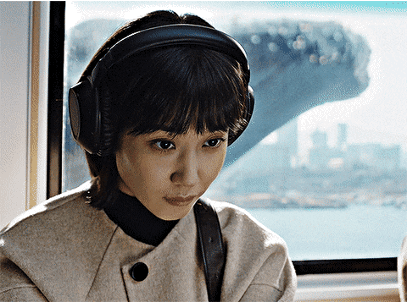
When the computer-generated whale shows up in the first episode, the effect is uncanny. We wonder at the spectacle of a giant sea creature emerging from the edge of the subway car window as the camera pushes in on Young-woo, whose imagination of the whale calms her anxiety of being trapped on the subway during the morning rush-hour commute. But as the scene cuts to a wide shot of the whale gliding through the sky, hovering over the subway train as the latter crosses one of the many bridges spanning the Han River, there is also an underlying sense of dread conditioned by the long history of screen monsters rising out of the water to terrorize urban structures, from Godzilla to King Kong to Bong Joon-ho's gwoemul ("monster") in The Host.
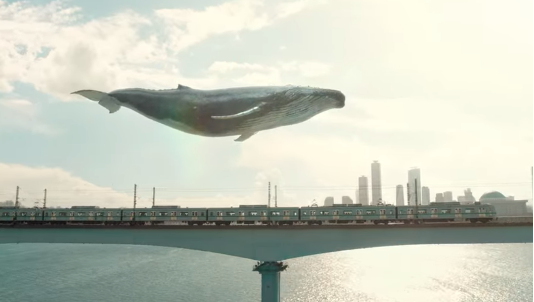
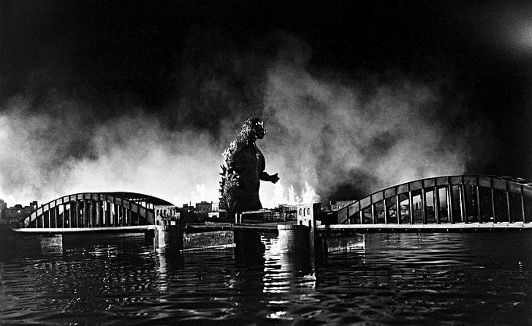
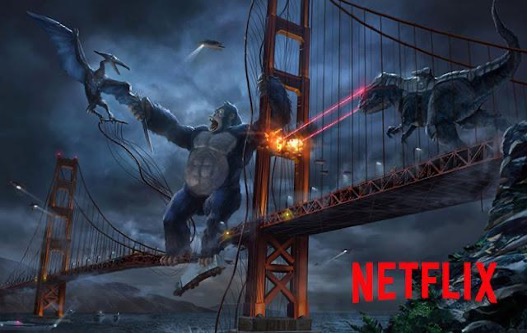
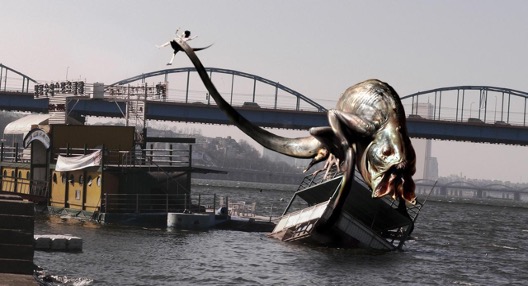
The postproduction special effects necessary for bringing these screen creatures to life constitute what Joshua Neves calls "one node of the global-popular."5 Godzilla's special effects, for instance, were inspired by the 1933 King Kong, and the specter of American imperialism embedded in the Japanese film's post-WWII context also articulates the film's anxiety surrounding technological derivativeness.6 More recently, the production of the Korean amphibious monster for The Host required transnational cooperation among visual effects studios in New Zealand, Australia, and Los Angeles, studios whose credits include such films as The Lord of the Rings trilogy, the King Kong reboot in 2005, and Pirates of the Caribbean: Dead Man's Chest.7
Extraordinary Attorney Woo invokes this cinematic and production history but deploys its sea creature to achieve a very different mood and for different narrative ends, signaling its own innovative genre crossing while showcasing the special effects expertise of the South Korean creative industry. The menacing Godzilla — or Gojira as it is known in Japanese, a portmanteau of the words for gorilla (gorira) and whale (kujira) — becomes the charming "goreka," a term screenwriter Moon Ji-won uses to describe Extraordinary Attorney Woo's technique for employing computer-generated whales (gorae in Korean) to depict Young-woo's eureka moments. The choice of animal reflects the ambitions of Global Korea, since gorae (고래) puns on Goryeo (고려), the premodern Korean dynasty from which the modern name Korea is derived. The whale also invokes through ironic reversal the Korean adage that "when whales battle, the shrimp's back breaks," a folk saying historically used to capture Korea's precarity as a small peninsula caught between greater powers (China, the US, Japan, and Russia). The implication in Extraordinary Attorney Woo, of course, is that the tidal wave of Korean popular culture has transformed the erstwhile shrimp into a powerful whale, a rhetorical move that BTS, Hallyu's ambassadors par excellence, make as well in their song "Whalien 52" (a reference to the 52-hertz whale), when they sing: "Even if I sleep a shrimp's sleep, my dreams are like that of a whale's."8
Already globally aspirational, the whale's digital rendering in Extraordinary Attorney Woo cites technological performance as evidence for its triumph. Hye Jean Chung argues that special effects in Korean blockbusters create "de-territorialized and trans-national" (54) virtual zones, but at the same time provide the occasion for an "identity crisis" as global media texts "strive toward global mobility while retaining cultural specificity" (48). Yet, what makes the VFX in Extraordinary Attorney Woo remarkable is its sure-handed re-territorialization of such a virtual zone as the most intimate expression of the way a particular body-mind encounters, relates to, and moves through the world. That world is socio-culturally specific, gradually constructed on screen as each case-of-the-week shines a spotlight on the diverse conditions of law — including labor rights, intellectual property, land redevelopment, inheritance, contracts, damages, cultural heritage, and data privacy — that organize daily life in South Korean society. One of the cases, for instance, turns on the difference between what constitutes robbery under North Korean vs. South Korean law. Unlike typical legal K-dramas that center around political machinations and revenge by the oppressed underclass on the corrupt elites, there are no personal villains orchestrating things behind the scenes.9 Instead, the "daily-life cases" (so described by Director Yoo In-sik) derive from real-life accounts in memoirs authored by South Korean lawyers, and are resolutely focused on the everyday struggles of regular people.
The show self-consciously underscores its own mobilization of the global as a site for the local through cases that appear sensationalist on first glance but are in fact thoroughly mundane in their concerns. The attempted murder charge in the first case, for instance, turns out to be a mere distraction. As Young-woo explains, "This case is a criminal case, so people will generally focus only on criminal law. But if you do that, you can't see the answer. The key is in civil law." The process of discovery by which Young-woo uncovers the two "hidden issues" in the first episode is represented on screen using computer-generated whales, providing a meta-commentary on the dazzling whale VFX as a global flex that entails its own hidden side.
As a behavioral characteristic used to index Autism spectrum disorder (ASD), the whale as special interest in Extraordinary Attorney Woo claims neurobiological grounding and proves transculturally resonant, further shoring up its deployment as a Hallyu trope. But the whale also provides a site for the articulation of local concerns. During the 2016-2017 candlelight vigils that called for the impeachment of then-South Korean-president Park Geun-hye, protestors marched with a large blue whale balloon in memory of the high school children who lost their lives in the Sewol Ferry disaster. More directly, the whale in the K-drama also invokes the issue of cetacean captivity in South Korea and its connection to the disgraced Seoul mayor Park Won-soon. In 2013, Park Won-soon was at the center of a nationally prominent campaign to free multiple Indo-Pacific bottlenose dolphins that had been illegally captured and held captive in aquarium tanks. The campaign's success, alluded to in episodes 4, 12, 13, and 14, turned the Indo-Pacific bottlenose dolphin into what scholars have described as a "conservation flagship" and made South Korea "the first East Asian country to release captive dolphins."10 Park had been a prominent human rights attorney who went on to serve three terms as Seoul's mayor, but died by apparent suicide in 2020 following allegations of sexual harassment.
This constellation of domestic issues invoked by Extraordinary Attorney Woo created public controversy following the broadcast of episode 12. Centering around a workplace gender discrimination lawsuit, the episode takes inspiration from the real-life 1999 Nonghyeop case, where a commercial bank undergoing neoliberal restructuring in the wake of the 1997 Asian Financial Crisis unfairly targeted women workers for layoffs by threatening them with their husbands' careers. In the K-drama, Young-woo's law firm Hanbada (literally meaning "one sea") is hired to defend Mir Life Insurance against two of the women employees it had forced to resign. The portrayal of the plaintiff's attorney Ryu Jae-sook as a passionate advocate for human rights drew conflicting lines of fire from domestic audiences, with some critiquing the show for its "feminist agenda" and others accusing the attorney figure as "a memorial to Park Won-soon." Park had been one of the legal representatives for the women plaintiffs in the Nonghyeop case, and his prominent association with Seoul's green roof initiatives while serving as mayor also linked him to Attorney Ryu, who farms vegetables on her office rooftop. While the drama production team has denied these allegations, stating that the episode is, like other episodes, excerpted from casebooks and has nothing to do with a specific person, the controversy spotlights the local exigencies that inflect the show's globally-aspirational grammar.
But Extraordinary Attorney Woo's investment in the local-popular goes beyond the representation of culturally-specific systemic forces to focus on how these forces shape the way individual bodies move through the world. Episode 12 spotlights how the legal institution sustains and reproduces gender discriminatory practices in the neoliberal workplace, practices that are themselves connected to labor flexibilization policies imposed upon South Korea by the IMF bailout during the Financial Crisis. While, in drama as in real life, the plaintiffs lost their suit, the show nevertheless explores the way in which the women continue to negotiate and challenge the power structures that oppress them through acts of solidarity that are at once political and personal.
The climax of the episode comes when the plaintiffs invite Young-woo and her colleague Soo-yeon to their "after-trial party." In the rooftop garden above Attorney Ryu's office, the women gather to prepare food, eat, and recite poetry. As Attorney Ryu stands up to read Ahn Do-hyun's "A Piece of Briquette," a poem about the everyday heroism of one who would "become a briquette, gladly / For someone else," the camera slowly pushes in and rotates around her and her audience, the wind ruffling the pages of her notebook and through the hair of those sitting by and listening to her. In the midst of this we see Young-woo's face lighting up, as a Yangtze River dolphin, which she had previously compared Attorney Ryu to, glides gracefully through the air, propelling itself forward to the rhythm of the lines of verse being read.
A figure for both the reciter and her listeners, the VFX dolphin here gives material form to what Kathleen Stewart calls "ordinary affects" — the "varied, surging capacities to affect and be affected that give everyday life the quality of a continual motion of relations, scenes, contingencies, and emergences."11 The scene makes tangible the sense that something is happening, a kind of resonance circulating among bodies, carried in and through the words of poetry, the ruffling wind, the wafting smells of plants and freshly-prepared bibimbap, the sun getting into the eyes of those present. While the legal battle had recently been lost and the women now gathering together fought on opposing sides, the affective circuit loosens up those formations and makes possible new alliances and novel "modes of knowing, relating, and attending to things."12 Young-woo, troubled by her role in the lawsuit, now contemplates possibilities as yet unarticulated — in particular, whether she will leave her big law firm and join hands with Attorney Ryu, a question that some viewers speculate will take center stage in the show's now-confirmed second season. The dolphin in the sky becomes the sign of not just some universalized global or simply the known and knowable local, but also of unforeseen socialities and worlds composed out of diverse dreams and singular lives.
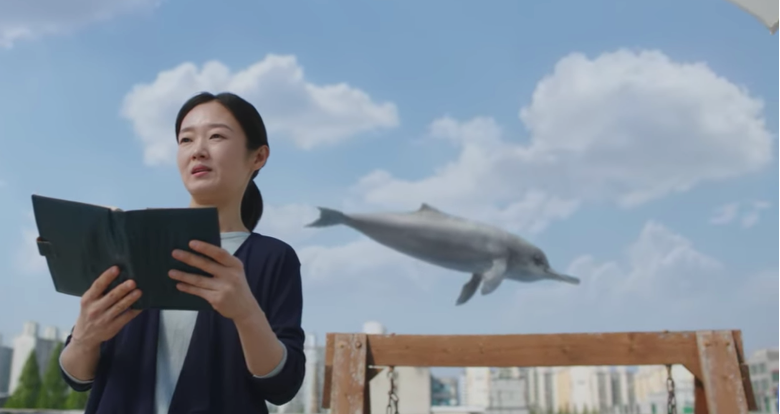
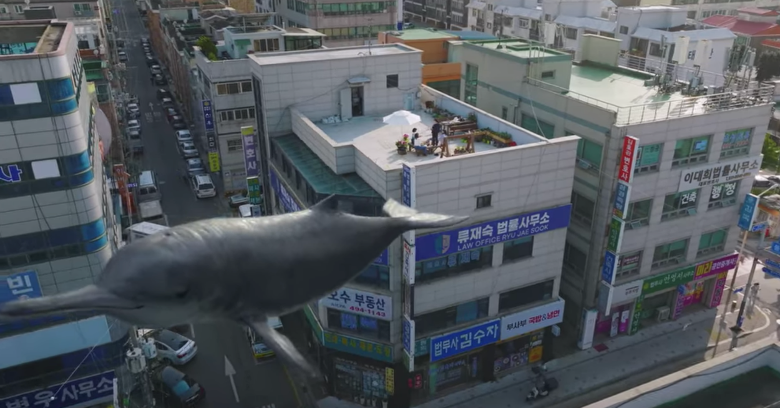
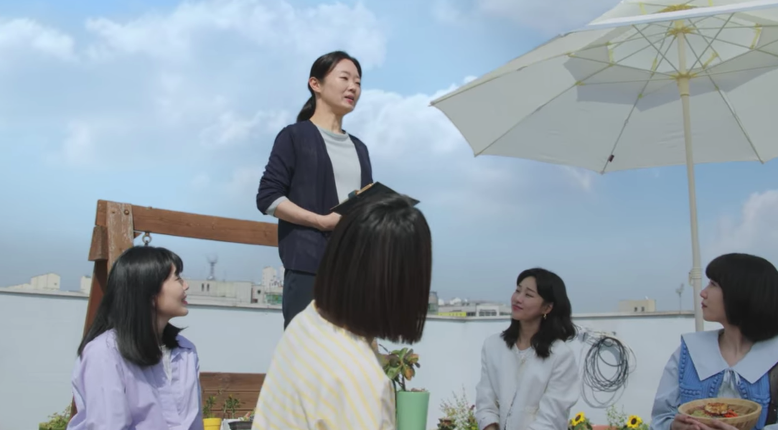
A similar moment occurs in episode 9, which interrogates the neoliberal logic of South Korea's private after-school education system through the morally ambiguous case of one "Mr. Fart," the self-styled Children's Liberation Army commander-in-chief who hijacked a hagwon (private cram school) bus and redirected it toward the mountains where the children can get off and play. While Mr. Fart is rightly indicted for the kidnapping of minors, the children rallying around him in the courtroom as they together proclaim the liberation army's manifesto — "First! Children must play immediately. Second! Children must be healthy immediately. Third! Children must be happy immediately" — marks a moment of heightened affective resonance. Communicated via quick camera cuts and zoom-ins and scored by a stirring piano soundtrack, the infectious joy of the children circulates throughout the courtroom and seizes the bodies of the judges, bailiffs, attorneys, and jurors, deterritorializing the legal apparatus that had been articulated and reinforced through their participation in the trial to pave the way for something new, contingent, unexpected.
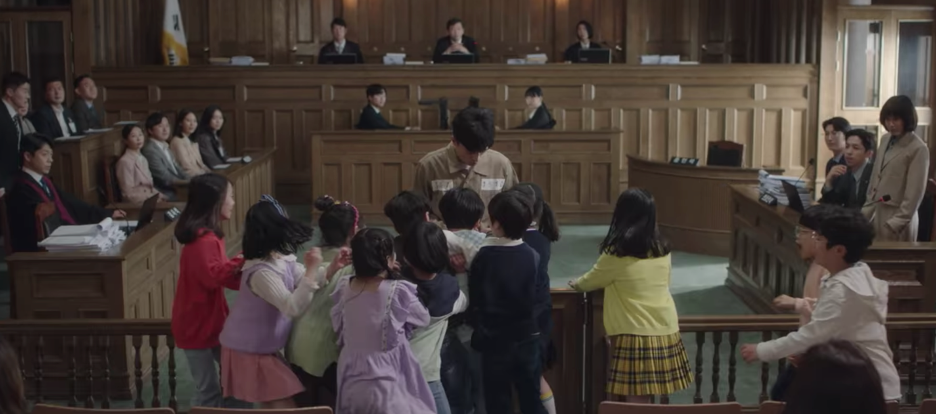
It is at this moment that the VFX whale appears before Young-woo's eyes, this time in the form of a captive orca — its bent dorsal fin indicates probable imprisonment within an aquarium — swimming out of the courtroom into freedom. Neither legitimizing Mr. Fart's behavior nor definitively condemning it, the whale's liberatory trajectory does not depend upon this or that verdict; crucially, and defying genre conventions of the typical legal drama, the show does not reveal the court's ultimate ruling. Rather, freedom lives in the emergent sense of an alternative possibility, a surging affect that remaps the relationships among those present in the courtroom and ruptures, if momentarily, the disciplinary frameworks of both law and education.
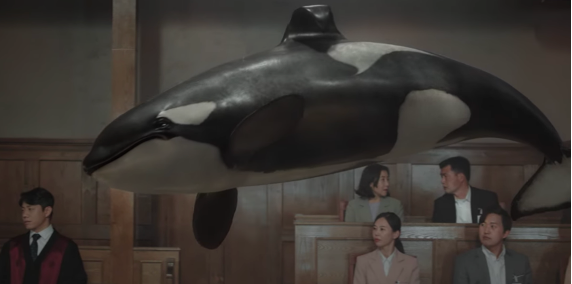
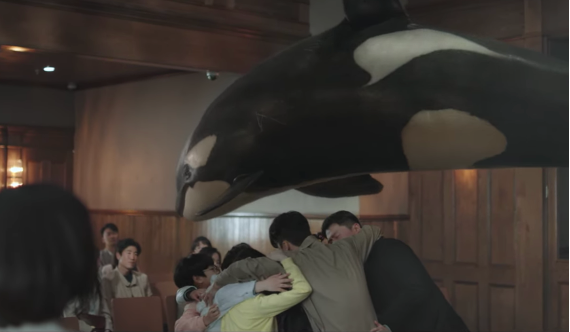
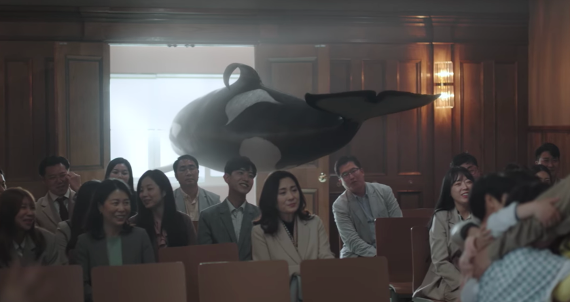
"Something," Stewart writes,"throws itself together in a moment as an event or a sensation; a something both animated and inhabitable."13 Repeatedly in Extraordinary Attorney Woo, the animated whale emerges into being, drawing our attention to such moments when oppressive systems press in on ordinary lives but are nevertheless negotiated, if not subverted, by the emergence of alternative lines of potential. The whale thus makes visible what Andre Cavalcante describes as the "taken-for-granted continuum of everyday life," situated as the everyday is, to follow Cavalcante in drawing on Alice Kaplan and Kristin Ross, "somewhere in the rift opened up between the subjective, phenomenological, sensory apparatus of the individual and reified institutions."14
This focus on the everyday is not unique to Extraordinary Attorney Woo, though the show stands out for the way it maps the everyday's operational logic onto the whale as a global-local motif. K-drama's intensifying investment in everyday life as the site of not just sociohistorical oppression but also creative transgression has become a trend evident in the growing visibility of the "slice-of-life" as a distinct K-drama sub-genre. Operating in the mode of what I call the "melodramatic mundane," these shows draw on excesses of plot to spotlight the social, economic, and political forces that made everyday existence precarious, even as they explore the potential that quotidian life provides for contesting those oppressive forces.15
Following Choi and Raley's argument that the "abyssal self-reflexivity" of K-content motivates audience investment and rewards growing levels of engagement, another way of thinking about K-drama's global popularity might be the way its focus on quotidian practices and affects cultivates self-reflexivity within the audience as well, who become more attuned to their own ways of inhabiting and negotiating a world structured by "codes, institutions, and paradigms."16 The oft-proclaimed therapeutic nature of K-dramas suggests that beyond just entertainment, audiences also derive from their viewing experience what sociologist Youna Kim terms "A-ha! Emotion," in which "ritualized viewing of their favorite drama surprisingly digresses toward a reflexive articulation of their intimate personal lives."17 K-dramas like Extraordinary Attorney Woo alert their audiences to the texture of their own everyday lives as spaces of the possible. Viewers catch the feelings of those on screen, whose faces, voices, postures, and movement function as what Anna Gibbs describes as "vector[s] of mediatized affect contagion."18 In this reading, K-drama's transcultural reach hinges not on the purportedly universal appeal of its content, but on its structural amplification of the feeling of enduring in the world, multiple and various as those worlds might be. It remains to be seen whether K-drama's creation of global-local grammars will yield ever richer resources for animating on screen the shimmering potentiality of everyday life.
Yin Yuan (@yinyuanx) is Assistant Professor of English at Saint Mary's College of California. Her book, Alimentary Orientalism: Britain's Literary Imagination and The Edible East, is forthcoming with Bucknell University Press, and her current project focuses on the cultural logic of K-drama genres.
References
- Bishnupriya Ghosh and Bhaskar Sarkar argue that "the global-popular does not stop at the critique of global techno-economic hegemonies," but rather "draws attention to ground-level activities in the local-popular arena" (4). See "The Global-Popular: A Frame for Contemporary Cinemas," Cultural Critique 114 (2022): 1-22. My conception of the global-local is inspired by their formulation. [⤒]
- The Korean title for Extraordinary Attorney Woo is 이상한 변호사 우영우, which literally translates to "Strange attorney Woo Young Woo." Domestic audiences typically refer to the show simply as "Woo Young Woo." [⤒]
- Yin Yuan, "Death Games and the Problem of Everyday Life: Squid Game, Liar Game, and South Korea's Melodramatic Mundane" (presentation, "Is Netflix Riding the Korean Wave or Vice Versa?," Seoul National University, April 8-9, 2022).[⤒]
- Separately, Suk-Young Kim has also pointed to the importance of the whale in Extraordinary Attorney Woo, reading the flora and fauna as representative of the K-drama's investment in what she provocatively describes as "symbiotic media." "Dolphin and Whales of Seoul: Toward Symbiotic Media in The Extraordinary Attorney Woo" (Keynote presentation, 2022 Situations International Conference, Jeju, South Korea, October 21-22, 2022).[⤒]
- Neves, "Southern Effects: Kaiju, Cultural Intimacy, and the Production of Distribution," Cultural Critique 114 (2022): 121.) ) As "a marker of technological exceptionalism, separating Hollywood from its purported imitators," VFX's growing prominence in Asian media spotlights the region's ambition for "transnational relevancy" through the adoption of Hollywood-style benchmarks.((Neves, "Southern Effects," 127, 129. "Transnational relevancy" comes from Hye Jean Chung, "The Host and D-War: Complex Intersections of National Imaginings and Transnational Aspirations," 49. [⤒]
- For the relationship between Godzilla and King Kong, see Neves 134. [⤒]
- See Chung, 51. [⤒]
- My thanks to Michelle Cho for alerting me both to the whale trope in BTS's oeuvre and to the presence of the whale during the 2016-2017 candlelight protests in South Korea, a point that comes up later on in this essay. [⤒]
- Taesan Law Firm, rival to the law firm that employs Young-woo, comes closest to a villain figure, especially in the class-action lawsuit case brought by Sodeok-dong residents against the government (episodes 7 and 8). Yet, Young-woo's firm would employ similar tactics in defense of powerful corporations in other cases (see episode 12 for instance), making it clear that the root of the problem lies not with any individual person or firm but with the discriminatory structure of capital and law. [⤒]
- Sejoon Kim and Bradley Tatar, "Dolphin Liberation in Korea: Is it Beneficial for Conservation?" Coastal Management 46, no. 3 (2018): 223. [⤒]
- Stewart, Ordinary Affects (Durham: Duke University Press, 2007), 1-2. [⤒]
- Stewart, Ordinary Affects, 3. [⤒]
- Stewart, Ordinary Affects, 1. [⤒]
- Cavalcante, Struggling for Ordinary: Media and Transgender Belonging in Everyday Life (New York: New York University Press, 2018), 6, 7. [⤒]
- Yin Yuan, "The Melodramatic Mundane in South Korean Television," Situations: Cultural Studies in the Asian Context (forthcoming). [⤒]
- Alice Kaplan and Kristin Ross, "Introduction," Yale French Studies, no. 73 (1987): 3. [⤒]
- Kim, "The Korean Wave: Korean Popular Culture in a Digital Cosmopolitan World," in Routledge Handbook of Korean Culture and Society, ed. Youna Kim (Oxon and New York: Routledge, 2017), 270. [⤒]
- Gibbs, "After Affect: Sympathy, Synchrony, and Mimetic Communication," in The Affect Theory Reader, eds. Melissa Gregg and Gregory J. Seigworth (Durham: Duke University Press, 2010), 192. [⤒]
